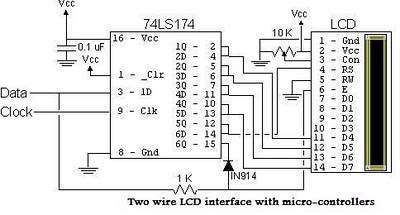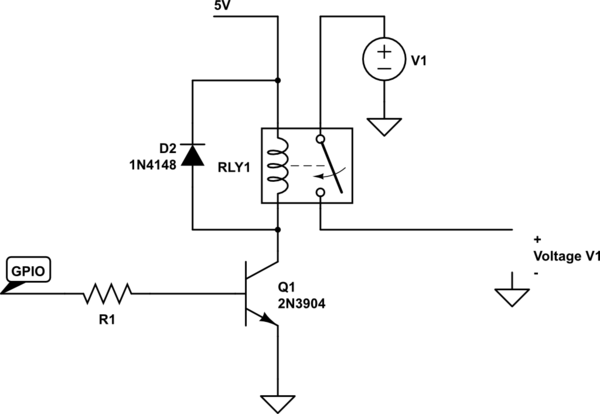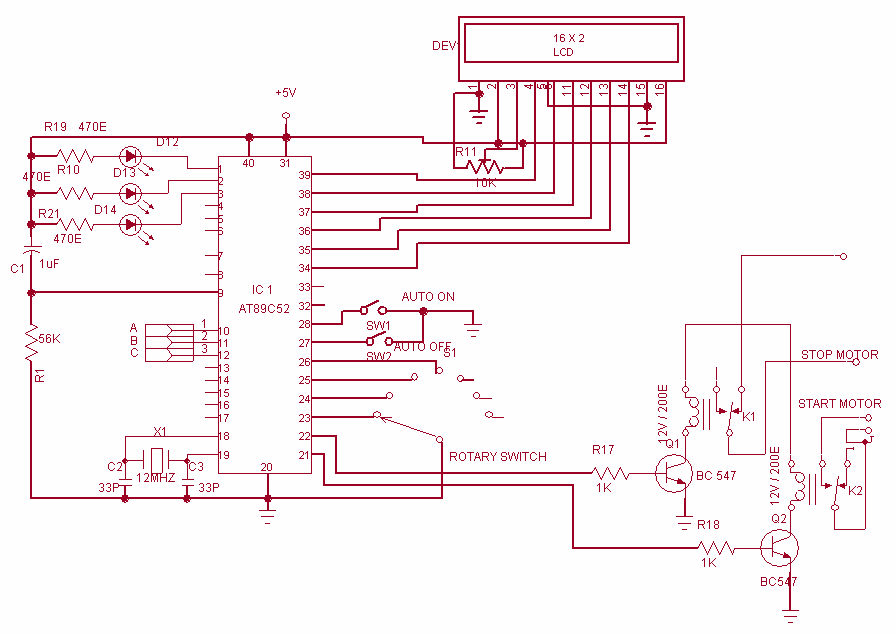
flasher and lighting control circuits

Hobby servos convert DMX signals into mechanical motion. Typically, hobby servos require a pulse with a variable width ranging from 1 to 2 milliseconds, with 1.5 milliseconds representing the center position. The schematic below illustrates a simple voltage-to-pulse-width circuit. This circuit functions as a basic oscilloscope trigger for analyzing DMX signals and is based on a 4528 CMOS monostable multivibrator. The "trigger" potentiometer is first adjusted until a short pulse is generated near the end of the "BREAK" portion of the DMX signal. Subsequently, the "delay" potentiometer is adjusted to focus on a specific portion of the signal. For DMX signals with fewer channels, it is effective to trigger the oscilloscope using the "trig" output instead of the "delay" output. This circuit can dim lights up to approximately 350 watts using a standard TRIAC circuit that generates minimal heat. However, it is important to note that this circuit is not suitable for use with fluorescent lights. A schematic is available through provided links. Many individuals have encountered difficulties sourcing the transformer needed for the Black Light project. Consequently, an alternative fluorescent lamp driver was investigated that does not require special components. This driver utilizes a standard 120 to 6V step-down transformer in reverse to convert 12V to about 350V to power a lamp without preheating the filaments. Component Q1 must be mounted on a heat sink, and a 240V to 10V transformer is recommended over the one listed in the parts list, although sourcing this transformer may be challenging. Caution is advised, as this circuit can deliver a dangerous shock. The strobe light serves practical purposes beyond providing visual effects for dancing in the dark. It can be used to observe fast-moving objects, inspect cracks in printed circuit boards (PCBs) by positioning the strobe on the trace side while viewing from the component side, and serves as an attention-grabbing device in store windows. The Adjustable Strobe Light is an enhanced version of the standard strobe light, featuring a more powerful "horseshoe" Xenon tube that emits increased light output. The flash rate can be controlled up to approximately 20Hz. Direct exposure to the flash tube should be avoided when in operation. The PIC microcontroller is a self-contained unit that includes an oscillator, EEPROM, and RAM. Any microcontroller can be utilized, depending on the user's programming preferences. MPLAB development software and a PICSTART PLUS programmer from Microchip are recommended tools. A diode may be included to prevent reverse polarity connections, although it can be bypassed if not needed. The circuit includes a 5W fluorescent lamp modulation test circuit, operating at a normal voltage of 250V. A switch must be engaged for two seconds to start the lamp, resulting in approximately 10 watts of peak modulated light output. All circuits operate at dangerous voltages, and caution is necessary. The pulse generation circuit serves as a lamp driver, and line filters are included for power supplies. A light dimmer controls the brightness level of an incandescent lamp, with the 555 timer configured as a variable cycle astable oscillator operating at around 300 Hz. The light dimmer schematic is depicted in figure 1 below. In theatrical and architectural applications, remotely controlled light dimmers utilize a 0-10V control signal to adjust lamp brightness, where 0V indicates the lamp is on and 10V signifies full brightness. The average voltage is regulated by controlling the phase at which the output TRIAC fires; earlier firing results in higher power applied to the lamp. The PIC16F873 light controller is included, along with several DOS programs used for generating patterns and converting them into an array.
The described circuit encompasses various functionalities, including pulse width modulation for hobby servos, DMX signal analysis, light dimming capabilities, and fluorescent lamp driving. The integration of a 555 timer for light dimming allows for precise control of incandescent bulbs, while the use of a PIC microcontroller enhances programmability and flexibility in controlling lighting systems. The safety considerations, such as the need for heat sinks and precautions against high voltages, emphasize the importance of proper circuit design and handling. Overall, the described circuits present versatile solutions for lighting control and signal processing in both hobbyist and professional applications.Hobby Servo`s Turn DMX signals into mechanical motion. Generally hobby servo`s require a pulse having a variable width from 1 to 2 milli seconds, with 1. 5mSec as the center position. The schematic below is a simple voltage to pulse width circuit. This is a simple O`scope trigger circuit for checking DMX signals. It is based on a 4528 CMOS monostable multivibrator. The "trigger" pot is adjusted first, untill a short pulse is generated near the end of the "BREAK" portion of the DMX signal. Then adjust the "delay" pot to zoom in on a portion of the signal. On DMX signals with few channels it works to trig the scope on the "trig" output, rather than the "delay" output.
This little circuit can be used to dim lights up to about 350 watts. It uses a simple, standard TRIAC circuit that, in my expirience, generates very little heat. Please note that this circuit cannot be used with fluorescent lights. Schematic is avialable here find in links, A number of people have been unable to find the transformer needed for the Black Light project, so I looked around to see if I could find a fluorescent lamp driver that does not require any special components. It uses a normal 120 to 6V stepdown transformer in reverse to step 12V to about 350V to drive a lamp without the need to warm the filaments.
Q1 must be installed on a heat sink. A 240V to 10V transformer will work better then the one in the parts list. The problem is that they are hard to find. This circuit can give a nasty shock. Be careful around the output leads. Disco anyone Actually, this strobe serves a much more useful purpose then making it look cool when you dance in the dark. You can use it to view fast moving objects, look for craks in PC boards (hold the strobe on the trace side of the board and look from the component side), and it is a great attention getter in a store window.
This Adjustable Strobe Light is the bigger brother of the plain old strobe light. This one uses a much more powerful "horse shoe" Xenon tube which produces more light. You can also control the flash rate up to about 20Hz. Do not look directly at the flash tube when this thing is on! The PIC is a self-contained microcontoller with oscillator, EEPROM, and RAM all built in. Mostany microcontroller will do, whatever you feel comfortable programming. I use MPLAB development software and a PICSTART PLUS programmer both from Microchip. The diode is only required for the polarity impaired like myself who may accidentally hook upthe battery backwards. You can short this connection out if you don`t feel like using a diode. 5 WATT FLUORESCENT LAMP MODULATION TEST CIRCUIT, NORMAL RUNNING VOLTAGE = 250V, SWITCH TO S FOR TWOSECONDS TO START LAMP, APPROX 10 WATTS OFPEAK MODULATED LIGHT, 5 WATT FLUORESCENT LAMP, DANGEROUS VOLTAGES EXIST ON ALL CIRCUITS, PULSE GENERATION CIRCUIT, LAMP DRIVER.
LINe filters for the power suplies. A light dimmer is a means of controlling the "brightness" level of an incandescent lamp, in this application we will use a 555 timer to control the brightness level of a low voltage incandescent bulb of up to 60 watts. The 555 timer "light dimmer" schematic circuit is shown in figure 1 below. For the light dimmer to work the 555 timer is configured as a "variable cycle", astable oscillator running some where around 300 Hz.
Light chaser Remotely controlled light dimmers in theatrical and architechtural applications use 0-10V control signal for controlling the lamp brightness. In this case 0V means that the lamp is on and 10V signal means that the lamp in fully on. A voltage between those values adjust the average voltage which is applied to the ligh bulb. This average voltage controlling is made by controllign the position in which phese the output triac fires (sooner it fires more power is applied to lamp).
PIC16F873 light controller Included are a couple of DOS programs that I used to generate the patternsand convert to an array rea 🔗 External reference
The described circuit encompasses various functionalities, including pulse width modulation for hobby servos, DMX signal analysis, light dimming capabilities, and fluorescent lamp driving. The integration of a 555 timer for light dimming allows for precise control of incandescent bulbs, while the use of a PIC microcontroller enhances programmability and flexibility in controlling lighting systems. The safety considerations, such as the need for heat sinks and precautions against high voltages, emphasize the importance of proper circuit design and handling. Overall, the described circuits present versatile solutions for lighting control and signal processing in both hobbyist and professional applications.Hobby Servo`s Turn DMX signals into mechanical motion. Generally hobby servo`s require a pulse having a variable width from 1 to 2 milli seconds, with 1. 5mSec as the center position. The schematic below is a simple voltage to pulse width circuit. This is a simple O`scope trigger circuit for checking DMX signals. It is based on a 4528 CMOS monostable multivibrator. The "trigger" pot is adjusted first, untill a short pulse is generated near the end of the "BREAK" portion of the DMX signal. Then adjust the "delay" pot to zoom in on a portion of the signal. On DMX signals with few channels it works to trig the scope on the "trig" output, rather than the "delay" output.
This little circuit can be used to dim lights up to about 350 watts. It uses a simple, standard TRIAC circuit that, in my expirience, generates very little heat. Please note that this circuit cannot be used with fluorescent lights. Schematic is avialable here find in links, A number of people have been unable to find the transformer needed for the Black Light project, so I looked around to see if I could find a fluorescent lamp driver that does not require any special components. It uses a normal 120 to 6V stepdown transformer in reverse to step 12V to about 350V to drive a lamp without the need to warm the filaments.
Q1 must be installed on a heat sink. A 240V to 10V transformer will work better then the one in the parts list. The problem is that they are hard to find. This circuit can give a nasty shock. Be careful around the output leads. Disco anyone Actually, this strobe serves a much more useful purpose then making it look cool when you dance in the dark. You can use it to view fast moving objects, look for craks in PC boards (hold the strobe on the trace side of the board and look from the component side), and it is a great attention getter in a store window.
This Adjustable Strobe Light is the bigger brother of the plain old strobe light. This one uses a much more powerful "horse shoe" Xenon tube which produces more light. You can also control the flash rate up to about 20Hz. Do not look directly at the flash tube when this thing is on! The PIC is a self-contained microcontoller with oscillator, EEPROM, and RAM all built in. Mostany microcontroller will do, whatever you feel comfortable programming. I use MPLAB development software and a PICSTART PLUS programmer both from Microchip. The diode is only required for the polarity impaired like myself who may accidentally hook upthe battery backwards. You can short this connection out if you don`t feel like using a diode. 5 WATT FLUORESCENT LAMP MODULATION TEST CIRCUIT, NORMAL RUNNING VOLTAGE = 250V, SWITCH TO S FOR TWOSECONDS TO START LAMP, APPROX 10 WATTS OFPEAK MODULATED LIGHT, 5 WATT FLUORESCENT LAMP, DANGEROUS VOLTAGES EXIST ON ALL CIRCUITS, PULSE GENERATION CIRCUIT, LAMP DRIVER.
LINe filters for the power suplies. A light dimmer is a means of controlling the "brightness" level of an incandescent lamp, in this application we will use a 555 timer to control the brightness level of a low voltage incandescent bulb of up to 60 watts. The 555 timer "light dimmer" schematic circuit is shown in figure 1 below. For the light dimmer to work the 555 timer is configured as a "variable cycle", astable oscillator running some where around 300 Hz.
Light chaser Remotely controlled light dimmers in theatrical and architechtural applications use 0-10V control signal for controlling the lamp brightness. In this case 0V means that the lamp is on and 10V signal means that the lamp in fully on. A voltage between those values adjust the average voltage which is applied to the ligh bulb. This average voltage controlling is made by controllign the position in which phese the output triac fires (sooner it fires more power is applied to lamp).
PIC16F873 light controller Included are a couple of DOS programs that I used to generate the patternsand convert to an array rea 🔗 External reference





